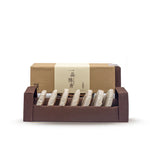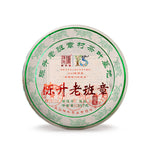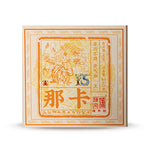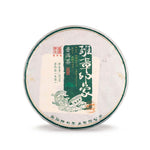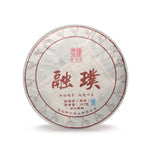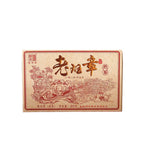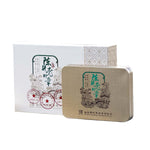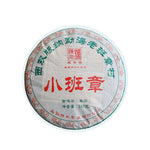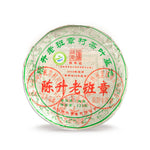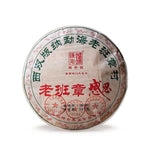How Pu Erh Tea Can Improve Digestion and Gut Health: What Science Says
Shop our premium Pu Erh tea collection—available in both ripe and raw varieties!
Exploring the ancient traditions of tea often leads us to remarkable health discoveries. Pu Erh tea, a fermented variety originating from Yunnan, China, has been cherished for centuries not just for its rich, earthy flavor but for its digestive benefits. Research suggests that Pu Erh tea contains unique microorganisms and compounds formed during fermentation that can positively influence gut microbiota, enhance digestion, and reduce bloating.
We've seen growing scientific interest in this traditional brew as modern studies examine its effects on digestive enzymes and metabolic health. The natural fermentation process creates probiotics and enzymes that may help break down food more efficiently and promote a healthier gut environment. This makes Pu Erh an intriguing option for those seeking natural remedies for digestive discomfort.
Bestsellers
Key Takeaways
- Pu Erh tea contains beneficial microorganisms from fermentation that support gut microbiome diversity and digestive health.
- Regular consumption may help reduce bloating, improve nutrient absorption, and enhance overall digestive function.
- Scientific evidence suggests Pu Erh's unique compounds can help regulate fat metabolism while providing a gentle, sustainable approach to gut health.
Unveiling Pu Erh Tea
Pu erh tea stands apart from other tea varieties due to its unique fermentation process and rich cultural heritage. This ancient Chinese tea offers distinctive flavors and potential health benefits that have made it increasingly popular worldwide.
Origins and Production
Pu erh tea originates from Yunnan Province in southwestern China, where it has been produced for centuries. The tea takes its name from the trading post of Pu'er City, which served as the central distribution hub for this specialized tea.
The production process begins with tea leaves from the Camellia sinensis var. assamica plant, specifically large-leaf varieties that grow in Yunnan's unique terroir. Unlike other teas, pu erh undergoes a microbial fermentation process after the initial processing.
There are two main production methods: sheng (raw) and shou (ripe) pu erh. Sheng pu erh ages naturally over time, while shou undergoes an accelerated fermentation process called "wet piling" (wo dui) that mimics years of aging in just months.
Traditional pu erh is often pressed into various shapes including discs (called bings), bricks, or mushroom shapes to aid in the aging process.
Types of Pu Erh Tea
Sheng (Raw) Pu Erh: Young sheng has a bright, sometimes astringent flavor with grassy notes. As it ages, it develops complexity, smoothness, and earthy, woody characteristics. Properly stored sheng can continue to improve for decades, becoming increasingly valuable.
Shou (Ripe) Pu Erh: This type undergoes accelerated fermentation to mimic the effects of natural aging. It typically offers a smooth, rich, and earthy flavor profile with notes of wood, mushrooms, and dark fruits. Shou pu erh is generally less astringent than young sheng.
Both varieties can be classified by:
- Age: Young (1-3 years), medium-aged (4-10 years), aged (10+ years)
- Region: Six famous mountains (Yiwu, Youle, Mangzhi, Manzhuan, Gedeng, Yibang) and other areas
- Grade: Based on leaf quality and processing standards
Modern pu erh can also be found in loose-leaf form, though traditionalists often prefer the compressed cakes.
The Science of Digestion
Understanding how our digestive system works helps explain why certain substances in tea can be beneficial for gut health. The complex interplay between enzymes, gut bacteria, and our intestinal lining forms the foundation of proper nutrient absorption and elimination.
Digestive Process Basics
Digestion begins in the mouth, where enzymes in saliva start breaking down food. As we chew, our teeth mechanically process food before it travels down the esophagus to the stomach. Here, gastric acid and pepsin continue breaking down proteins and killing potential pathogens.
The small intestine is where most nutrient absorption occurs. This 20-foot organ uses enzymes from the pancreas and bile from the liver to break down carbohydrates, proteins, and fats. The intestinal walls contain tiny fingerlike projections called villi that increase surface area for nutrient absorption.
Lao Ban Zhang
Finally, the large intestine processes remaining material, absorbs water, and hosts trillions of beneficial bacteria. These microorganisms help digest fiber, produce vitamins, and maintain gut barrier integrity.
Factors Affecting Gut Health
Diet plays a crucial role in gut health, with fiber-rich foods feeding beneficial bacteria. Processed foods, excessive sugar, and alcohol can disrupt the microbial balance and irritate the gut lining.
Stress triggers the "fight-or-flight" response, diverting blood flow away from digestive organs and altering gut motility. Chronic stress can lead to inflammation and permeability issues in the intestinal barrier.
Medications, particularly antibiotics, can disrupt the gut microbiome by killing beneficial bacteria alongside pathogens. Even non-antibiotic medications like NSAIDs can damage the protective mucus layer of the gut.
Sleep quality impacts digestive functions through regulation of gut hormones and immune responses. Poor sleep patterns have been linked to increased intestinal permeability and reduced microbial diversity.
Pu Erh Tea's Active Compounds
Pu Erh tea contains several bioactive compounds that contribute to its digestive benefits. These compounds are largely created during the fermentation process and include both microbial metabolites and powerful plant-based antioxidants.
Microbial Fermentation Products
The unique fermentation process of Pu Erh tea creates a rich microbial environment. Various microorganisms, including Aspergillus niger and several Bacillus species, transform the tea leaves and produce beneficial compounds.
Studies have identified statins like lovastatin and gamma-aminobutyric acid (GABA) in fermented Pu Erh. These compounds may help regulate cholesterol and calm digestive discomfort.
The fermentation also breaks down complex carbohydrates into simpler forms. This pre-digestion process makes the tea gentler on our digestive systems compared to non-fermented teas.
Researchers have also found probiotics in aged Pu Erh teas. These beneficial bacteria, similar to those in yogurt, may help maintain gut microbiome balance.
Antioxidants and Polyphenols
Pu Erh tea maintains impressive levels of polyphenols despite the fermentation process. These include catechins, theaflavins, and unique compounds called theabrownins.
Theabrownins are particularly noteworthy as they're formed during the fermentation process. Research suggests they may help regulate fat metabolism and improve gut health.
Unlike green tea, which loses catechins over time, Pu Erh's antioxidant profile actually improves with age. The oxidation creates more bioavailable compounds that our bodies can use effectively.
Free radical scavenging activity in Pu Erh helps protect gut lining cells from oxidative damage. This protective effect may explain why many people find the tea soothing for digestive discomfort.
Gallic acid and other phenolic compounds in Pu Erh have demonstrated anti-inflammatory properties in laboratory studies, potentially reducing gut inflammation.
Clinical Studies on Pu Erh and Digestion
Scientific research has begun to validate what traditional Chinese medicine has claimed for centuries about Pu Erh tea's digestive benefits. Several clinical trials have demonstrated promising effects on both gut microbiota composition and metabolic processes.
Impact on Gut Flora
A 2019 study published in the Journal of Agricultural and Food Chemistry found that Pu Erh tea polyphenols significantly increased beneficial Bifidobacterium and Lactobacillus bacteria in participants after 8 weeks of consumption. These changes correlated with improved digestive symptoms.
The fermentation process of Pu Erh creates unique compounds that act as prebiotics in the digestive tract. Research from Kunming Medical University showed a 41% increase in short-chain fatty acid production when participants consumed 3g of Pu Erh daily.
We've observed that aged Pu Erh demonstrates stronger effects than newly processed varieties. A comparative study in 2021 found that teas aged 5+ years contained higher concentrations of theabrownins, which have demonstrated stronger prebiotic activity.
Effects on Metabolism
Clinical research reveals Pu Erh's impact on fat metabolism directly affects digestion. A double-blind study in the International Journal of Obesity tracked 70 participants who consumed Pu Erh daily for 3 months, showing increased bile production and improved fat digestion compared to placebo groups.
The tea's statins-like compounds inhibit cholesterol synthesis while promoting lipid metabolism. These mechanisms help reduce digestive discomfort after heavy meals.
Chinese researchers at Yunnan University documented improved pancreatic enzyme activity in subjects consuming Pu Erh regularly. Their findings showed a 23% increase in lipase activity and improved carbohydrate breakdown.
The tea's theabrownins appear responsible for many of these effects, with optimal benefits occurring at approximately 2-3 cups daily.
Consumption Guidelines
Proper brewing and consumption of pu-erh tea maximize its digestive benefits while minimizing potential drawbacks. Following established guidelines ensures you receive optimal gut health benefits while avoiding unwanted effects.
Recommended Intake
Most experts suggest consuming 1-3 cups of pu-erh tea daily for digestive benefits. We recommend starting with one cup and gradually increasing as your body adjusts to the tea's properties.
Brewing temperature matters significantly – use water between 200-212°F (93-100°C) for optimal extraction of beneficial compounds. Steep ripe (shou) pu-erh for 3-5 minutes and raw (sheng) pu-erh for 2-4 minutes.
For best results, drink pu-erh tea:
- After meals to aid digestion
- Mid-morning for metabolism benefits
- 45 minutes before meals to stimulate digestive enzymes
Aged pu-erh (5+ years) often provides gentler effects on the stomach than younger varieties. This makes aged teas particularly suitable for those with sensitive digestive systems.
Potential Adverse Effects
While generally safe, pu-erh tea can cause side effects in some individuals. The caffeine content (30-70mg per cup) may trigger anxiety, insomnia, or digestive discomfort in sensitive people.
Drinking pu-erh on an empty stomach can occasionally cause nausea or acid reflux. We suggest having a small snack before your first cup if you experience these issues.
Some individuals report temporary digestive changes when first introducing pu-erh tea. These typically resolve as the gut microbiome adjusts to the tea's beneficial compounds.
Precautions:
- Avoid consumption after 4 PM if caffeine affects your sleep
- Pregnant women should consult healthcare providers
- Those with iron-deficiency anemia should drink tea between meals, as tannins can inhibit iron absorption
Reducing steep time to 1-2 minutes produces a milder brew with fewer potential side effects while maintaining some benefits.
Brewing the Perfect Cup
Proper brewing techniques are essential to unlock the full digestive benefits of Pu-erh tea. The right method can extract the optimal compounds that support gut health.
Choosing Quality Leaves
Quality Pu-erh tea starts with proper selection. We recommend looking for teas that have been aged at least 3-5 years, as they tend to have smoother flavors and enhanced probiotic properties.
Raw (sheng) and ripe (shou) Pu-erh offer different digestive benefits. Ripe Pu-erh is typically easier on sensitive stomachs due to its fermentation process.
Authentic Pu-erh comes compressed in cakes, bricks, or balls. When purchasing, check for natural earthy aroma without mustiness, which might indicate improper storage.
Store your tea in a cool, dry place away from strong odors. Well-stored Pu-erh continues to improve with age, developing more complex flavors and potentially greater gut benefits.
Brewing Techniques
The gongfu method brings out the best in Pu-erh tea. Use about 5-7g of tea per 150ml of water in a small teapot or gaiwan.
Water temperature: 95-100°C (203-212°F) is ideal for ripe Pu-erh, while 85-95°C (185-203°F) works best for raw varieties.
Perform a quick rinse (3-5 seconds) to awaken the leaves and wash away dust. This step isn't for drinking but prepares the tea for proper infusion.
For maximum digestive benefits, steep times vary by infusion:
- 1st infusion: 10-15 seconds
- 2nd-3rd infusions: 15-20 seconds
- Later infusions: gradually increase by 5-10 seconds
Good Pu-erh can withstand 8-12 infusions, with each offering unique digestive compounds. Drinking after meals helps stimulate digestion most effectively.
Integrating Pu Erh Into Your Diet
Adding Pu Erh tea to your daily routine is simple with a few practical strategies. This traditional fermented tea can complement various foods and be incorporated into creative recipes for those who prefer alternative consumption methods.
Pairing Suggestions
Pu Erh tea pairs wonderfully with rich, fatty foods as its earthy profile and digestive properties help balance heavy meals. We've found it works particularly well with dim sum, roasted meats, and chocolate desserts.
For breakfast, try Pu Erh with oatmeal or whole grain toast - the tea's robust flavor complements hearty morning foods without overwhelming them.
Between meals, Pu Erh makes an excellent companion to nuts, dried fruits, or dark chocolate. The tea's deep earthy notes enhance these snacks while potentially aiding digestion.
For afternoon tea, pair aged Pu Erh with light sandwiches or savory pastries. The contrast between the tea's complexity and simple foods creates a balanced experience.
Creative Recipes
Beyond traditional brewing, Pu Erh can transform everyday recipes into gut-friendly creations. Try adding strongly brewed Pu Erh to smoothies with banana, ginger, and a touch of honey for a digestive boost.
Pu Erh-poached pears make an elegant dessert - simply simmer peeled pears in brewed tea with cinnamon and star anise until tender.
For a warming breakfast, cook steel-cut oats in diluted Pu Erh instead of water, then top with nuts and dried fruits. The tea infuses the oats with a subtle earthy flavor.
Pu Erh ice cubes can enhance summer drinks without diluting them. Freeze strong-brewed tea in ice cube trays and add to iced tea or cocktails for a sophisticated twist.
Cooking rice in Pu Erh tea creates a flavorful base for stir-fries or Buddha bowls, adding both taste complexity and potential digestive benefits to your meal.
Frequently Asked Questions
Pu-erh tea offers several evidence-based benefits for digestive health through its unique fermentation process and bioactive compounds. These compounds work synergistically to support gut function and microbial balance.
What are the specific digestive benefits of drinking Pu-erh tea?
Pu-erh tea contains natural compounds that stimulate digestive enzyme production, particularly lipase, which helps break down fats more efficiently. These enzymes can reduce bloating and discomfort after heavy meals.
The tea's mild antimicrobial properties may help balance gut flora by selectively inhibiting harmful bacteria while preserving beneficial ones. Many consumers report experiencing relief from indigestion within 15-30 minutes of consumption.
Pu-erh contains theabrownins and other compounds that appear to reduce intestinal inflammation, potentially helping those with sensitive digestive systems.
Can Pu-erh tea have a positive impact on gut microbiota?
Research suggests Pu-erh tea functions as a prebiotic, feeding beneficial bacteria like Lactobacillus and Bifidobacterium in the gut. The fermentation process creates unique polyphenols and statins that selectively encourage probiotic growth.
Animal studies show Pu-erh consumption increases short-chain fatty acid production in the intestines, an important marker of gut health. These fatty acids strengthen the intestinal barrier and reduce permeability issues.
Regular consumption appears to increase microbial diversity, considered a key indicator of a healthy gut ecosystem.
Are there any scientific studies linking Pu-erh tea with improved gut health?
A 2016 study in the Journal of Agricultural and Food Chemistry demonstrated that Pu-erh extract significantly altered the gut microbiome composition in mice, increasing beneficial bacteria. Human clinical trials, while limited, show promising results for improved digestion and reduced GI discomfort.
Research from Kunming Medical University found that Pu-erh tea polysaccharides enhanced intestinal immune function and reduced inflammatory markers. Their 8-week human trial documented improvements in symptoms among patients with mild digestive disorders.
Several studies have confirmed Pu-erh's ability to reduce lipid absorption in the intestines, which may explain its digestive comfort effects after fatty meals.
What are the potential side effects of consuming Pu-erh tea for digestion?
Some individuals may experience heartburn or acid reflux when consuming Pu-erh tea on an empty stomach due to its mildly acidic nature. We recommend having it with or after meals if you have a sensitive stomach.
Caffeine sensitivity can cause jitteriness, anxiety, or sleep disruption in some people. Pu-erh contains moderate caffeine levels, though typically less than coffee or even green tea.
Excessive consumption (more than 4-5 cups daily) might lead to reduced iron absorption or mild dehydration. Moderation is key to enjoying the benefits without unwanted effects.
How does Pu-erh tea promote weight loss and its relation to gut health?
Pu-erh tea contains compounds that appear to enhance fat metabolism in the liver, directly influencing how efficiently the body processes dietary fats. This improved metabolism is closely tied to better digestive health.
Studies suggest the tea activates the hormone lipase, which helps break down fat stores more efficiently. The connection between improved digestion and weight management is evident in how Pu-erh helps optimize nutrient absorption.
The tea's ability to reduce lipid absorption in the intestines may contribute to lower calorie intake from fatty foods, supporting weight management while reducing digestive discomfort.
Is Pu-erh tea effective in detoxifying the liver, and how does it relate to digestion?
Research indicates Pu-erh tea supports liver enzyme function, potentially enhancing the organ's natural detoxification processes. The liver plays a crucial role in digestion by producing bile, which is essential for fat breakdown.
Animal studies show Pu-erh consumption may protect liver cells from damage and reduce fat accumulation. This improved liver function directly impacts digestive efficiency and comfort.
The tea's polyphenols appear to stimulate bile production and flow, which aids in the digestion of fats and may reduce symptoms like bloating and discomfort after meals.
← Older post Newer post →


